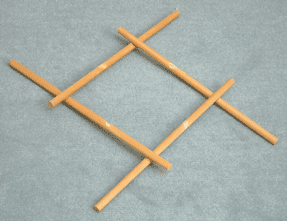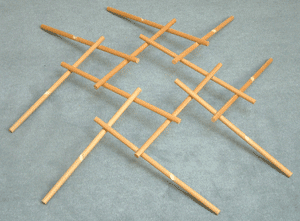Abstract
In 1989, I began constructing domes using notched bars assembled according to a simple rule. This led me to explore planar constructions based on this rule using fixed length "notched" line segments. I was able to create a wide variety of patterns. Based on certain of these patterns I was able to construct spheres and cylinders from notched curved rods without the use of glue, rope, nails, or screws. Surprisingly, drawings found in the notebooks of Leonardo da Vinci suggest that he too explored constructions based on this simple rule.
1. Bar Grids
In 1989 I found a way to build domes using simple rods in such a manner that the rods require no fastening materials like nails, screws, wire and so on.
The construction admits a simple description. So we start with a number of rods. On each rod we determine four points as indicated in figure 1. We call these points connecting points. We distinguish two types of connecting points: End points (closest to the ends of the rods and interior points (the remaining points). So each rod has two end points and two interior points.

Now the actual construction of the dome turns out to be a simple task. Beginning with four rods as in figure 2 we extend the construction by continually adding rods at the bottom (see figure 3). Since we add one rod at the time, on the outer edge, the dome can be constructed by one person. The four poles with which we have started will rise automatically during the building process and at the end the dome, consisting of 64 rods rests on the earth with only 16 rods (see figure 4).

